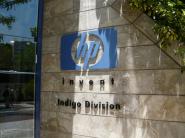Wrapping It Up at HP Indigo
- Published: June 29, 2010, By Yolanda Simonsis
Our HP Indigo tour was nearly complete except for a final chat with Gary Bernier, HP Indigo's Strategic Business Brand Development Lead. He shared with the mixed audience (both converter customers and editorial-type people like me) the kind of sales support the company provides.
It's been my contention over the course of all these years during which digital has been evolving that sales for this type of printing had to be different. Conventional printing processes by their very nature–even if “quick turnaround” translates into less than a week from order to delivery–employ a different sales approach. My guess is that the sales approach is more long-range oriented. Digital, on the other hand, defines “quick turnaround” in a whole different manner. To fill up a press with work that keeps pumping out product simply must be take a different approach.
That's where Gary's expertise and support comes in. He emphasized the importance of digital press owners not just selling labels but selling solutions. He reported that brand owners are calling HP Indigo now and have invited it with their customer base to sell the “partnership” to them. Gary added that the success of HP Indigo has related directly to its customer base after sales.
Among the sales and marketing advantages HP offers are newsletters, case history applications, vertical market studies, D-Scoop (Digital Solutions Cooperative) membership, a Capture Business Success toolkit, digital sales training courses, and other marketing support. In addition, sales training is offered at a company's plant and is designed to show how to present digital to a printer's customers as well as what pitfalls to avoid. HP marketing support claims to help its customers tackle some pretty complex business issues, such as where your company has come from; where you are now; where you want to go; and how you are going to get there. Support even provides a sample marketing calendar that integrates news releases, open houses, trade shows, suggested organizations for design conferences, just to name a few things.
It's not the norm for a supplier to welcome its customers, potential customers, and the trade press to an event where they're able to share the secrets of their success as well as their challenges. I appreciated the opportunity to sit down with HP Indigo customers on a one-on-one basis at breakfast or dinner to learn the nature not only of their positive digital experiences but their pain as well and how HP has responded to their needs.
Quite honestly, if digital moves forward to become the accepted technology of the present rather than something referenced as the future of print, it will be because of the full support of leading companies like HP that make it so. Perhaps Benny Landa's prediction in the early '90s is closer than we think: “Everything that can become digital will become digital–and printing is no exception.”
Left: Indigo was the center of attention on the eve of the digital revolution with an announcement on Jan. 25, 1995, stating it had introduced the world's first digital color printing technology for the packaging market with its Omnius digital Offset Color Press. HP announced its intent to purchase Indigo on Sept. 6, 2001.
Right: From the Mount of Olives, HP takes its guests to view the Dome of the Rock built over Temple Mount in Jerusalem–what many over millennia have called the center of the world.






